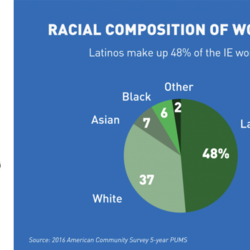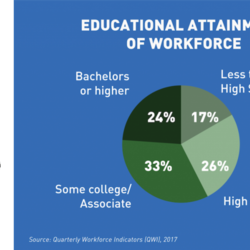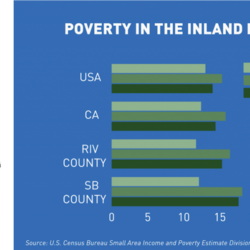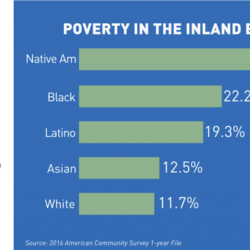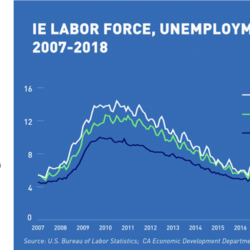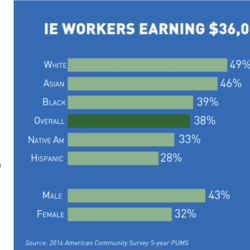Center for Social Innovation
State of Work in the Inland Empire
This report provides an overview of the state of work in the Inland Empire region of Riverside and San Bernardino Counties, an area that accounts for one of every 9 California residents. The region has added over 300,000 jobs since the peak of unemployment in July 2010, with logistics and healthcare driving much of the gains. At the same time, only about 4 in 10 jobs pay enough for working families to make ends meet. This problem is particularly acute for communities of color, a majority of the region’s workforce.
Improving earnings, benefits, and job stability for workers in the Inland Empire would not only help families in poverty, it would also increase consumer spending and local revenues, creating positive ripple effects for the entire regional economy.
Community Profiles
-
Sandra
Location: San Bernardino
Gender: Female
Occupation: Homecare ProviderSandra is a homecare provider through California’s In-Home Supportive Services (IHSS) program and a member of the Service Employees International Union (SEIU) Local 2015.
Prior to becoming a homecare provider, Sandra was a single parent and a manager at a company and volunteered at a homeless shelter, where her mother worked as a cook for 18 years. When her mother fell sick, Sandra had to stop working as a manager to take care of her mother. The drop in income left Sandra and her without a house and dependent on the charity of others.
For a year, Sandra stayed with various family members, never telling them that she was homeless, and noting instead that she was visiting them because she needed a place to shower, eat, and connect her mother’s machine. After that year, Sandra learned about the IHSS Program.
The IHSS Program was a life saver for Sandra. With the little money she could save, Sandra rented a garage, which the landlord eventually converted into a small apartment, for which she paid $822 a month.Sandra is an active member of the union SEIU Local 2015. SEIU Local 2015 is currently seeking to provide IHSS workers with a wage increase, healthcare benefits, and training. For Sandra,
it is extremely important to receive a wage increase, because she does not want to worry about whether she will have enough money for food or to pay electricity bills, with her mother dependent on life-support machines. She notes that, on average, a care provider in the region earns about $14,000 a year, which is not nearly enough to meet basic needs. This approximate annual income has remained fixed for the last 10 years.In addition to wage increases, Sandra and other SEIU 2015 members also seek to obtain job training for homecare providers, who carry out many of the same tasks as Certified Nurse Assistants for the elderly and disabled.
-
Anna
Location: Riverside Metro
Age: late 20s
Gender: Female
Occupation: Retail Sales Worker; Fast Food Restaurant WorkerAnna has worked as a customer service associate for a restaurant and a retail clothing store. In both occupations, Anna recalls her jobs as low-wage and extremely challenging. As she explains, “The management was terrible. The way situations were handled and overlooked… Management just didn’t care.” While she worked at the restaurant, she never received overtime pay, even though, at times, she had to work overtime hours.
Retail sales work was not at all better. For Anna, working at the clothing store was excessively stressful because, at the time she was juggling work, school, and personal obligations. Work schedules were unpredictable. Anna knew when she had to clock-in, but she never knew when she would be able leave work because all employees had to stay until the store was neat and spotless.
This became a big problem for Anna. Her grades began to suffer, and she was always running on little to no sleep. Anna typically entered work at 10pm and ended at 5am, and often had to be at school by 8am. As Anna describes the management style in retail, “they work with our school schedule but when it came to our deadlines, management was inconsiderate; they didn’t understand our individual situation as employees.”
Through this interview, Anna hopes to create awareness and shed light on the working and employment conditions many retail workers have to endure because
of necessity. She hopes that, along with greater awareness of the problem, there will be greater enforcement of workplace standards and protections, and improved conditions in retail and restaurant jobs.
-
Marissa
Location: Coachella Valley
Gender: Mid-to-late 20s
Gender: Female
Occupation: Peer educatorMarissa has worked for more than 5 years as a Peer Educator and even longer in the Coachella Valley Unified School District. Marissa’s current job entails working with elementary school students with moderate to severe disabilities. This work can be very challenging and emotionally exhausting. As Marissa describes, “Due to working with special need students, every day is a different experience. There are days where we might have a smooth day, but there are days where we have behavior problems such as, students hitting us, fighting us, spitting on us, scratching us, or trying to hurt themselves or other students.” The work also entails supporting students with severe medical conditions, “so pretty much our day is based on how our students are feeling.”
On the other hand, Marissa appreciates how her job has enabled her to profoundly impact and make a difference in her students’ lives. She tells me, “it is gratifying to see my students undergo multiple levels of academic progress and to ultimately see them pursue their academic goals.” In addition, Marissa also enjoys the family-friendly nature of her job schedule, and her employment benefits.
Marissa is primarily concerned about the massive deficit and budget cuts in the school district, which has resulted in massive layoffs and the relocation of teachers, behavioral specialists, peer educators, attendance data clerks, kitchen workers, and other district workers in various departments. Deficits have also increased student-teacher ratios, creating new risks and challenges for students and employees alike.
Depending on the school district, public K-12 employees will have different employment benefits, such as health care insurance. While Marissa is fortunate to have full health care coverage, in neighboring school districts, such as Palm Springs Unified School District and Desert Sands Unified School District, she has heard that employees have to pay out of pocket for their health insurance. As a result, many school employees instead rely on public health insurance programs, such as MediCal.
-
Linda
Location: San Bernardino metro
Gender: Female
Occupation: Warehouse workerLinda is a full-time warehouse worker for Stater Brothers, a regional grocery chain, where she has worked for 15 years. Linda works during the night shift, and usually helps select items to fill orders for Stater Brothers stores. Sometimes she also works to keep the warehouse clean of spills or debris, which helps prevent workplace accidents.
Linda is a proud member of Teamsters Local 63 and comes from a union family. Her father was a truck driver who was also represented by the Teamsters as is her husband, who is also employed as a ware- house worker for Stater Brothers. Her union contract provides her with good pay ($26/hour of standard
pay and $13/hr of bonus pay during periods in which she exceeds the standard level of productivity), good benefits, and employee protection, which is why
she has stayed employed as a warehouse worker at Stater Brothers for so long. Linda and her husband are sometimes expected to work overtime, especially during holiday seasons or other busy periods.Linda and her husband greatly value their union contract which provides them with employer-provided benefits, including health insurance for her family,
a generous retirement pension, sick days, and paid vacation time (which varies by employees’ length of service). Because she has worked at Stater Brothers for 15 years, Linda will have 4 weeks of paid vacation time beginning this year. Employees who have worked for the company for 5-14 years are given 3 weeks of paid vacation time, while employees that have worked for less than 5 years are given one week of paid vacation time.Linda enjoys having the protection of the union, which advocates for their members if needed and ensures that the company complies with labor laws and treats their employees fairly. During her work shift, she is always given the required work and meal breaks.
Linda’s daughter is currently employed as a ware- house worker for Amazon and lacks union representation. Her daughter earns less than her parents and has fewer benefits. Although Amazon offers health insurance for their employees, her daughter could not afford to use it for her family. The monthly cost of this insurance would be about half her monthly income. For this reason, her daughter, who is not yet 26, is covered through her parents’ health insurance plan.
-
Michael
Location: Riverside County
Gender: Male
Industry: Public Administration
Occupation: Food Services SupervisorMichael is a member of SEIU Local 721 and a Riverside County employee over many years. Although Michael enjoys being a county employee represented by a union, he and his family have been adversely affected by the county’s budget deficit and related woes, such as staff layoffs and downsizing of departments, and uncertainty over the timing and terms of a new contract agreement between the County of Riverside and union mem- bers.
Michael explains that, in July 2017, Riverside County sent a notice to all unions notifying them of their current budget crisis, and ultimately, inform- ing them that they did not have enough money to support any form of raises and any increases in medical health insurance costs. Yet, Michael and other county employees question the wisdom of the county spending upwards of 40 million dollars on a private consulting firm, even as it struggles with its budget woes.19 As Michael puts it, “the county is currently not giving us a fair contract, because they claim they have no money, but they are spending it in things they shouldn’t have.”
Currently, Michael is still worried about impacts that county budget cuts will have on his job stability and economic security. As a result of the budget uncertainty and union contract stalemate, Michael has had to sell one of his cars, so he could have some income saved in case there is a radical change in his employment status and/or benefits. Michael has also started working a second job,
in the event that contract negotiations with the county go sour.
If Riverside County workers lose a decent and fair contract Michael notes, “people will lose hope, faith in their union, and a lot of people will lose personal assets.” He is especially worried about families who have more than one family member working for the county. Nevertheless, Michael continues to work with his union in pushing for a fair agreement regarding health care and retirement benefits and cost of living pay raises.
